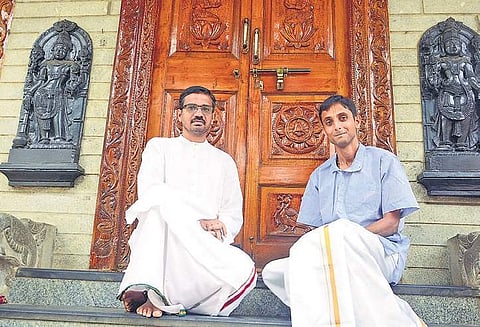

BENGALURU: It took four hours for the ‘treasure hunters’ to vandalise the 16th-century Vysaraja Brindavana at Anegundi near Hampi on July 17. But it was the cumulative knowledge of science, mathematics, history and scriptures which came to the rescue of those involved in the challenging task of resurrecting the 500-year-old structure in nineteen-and-a-half-hours.
Among those who played a key role in rebuilding the Brindavana to its original glory were two Bengaluru-based individuals — architect and scholar KM Sheshagiri and sculptor Nagendra Ramamurthy. Sheshagiri was chief architect of the 32-foot monolithic statue of Madhwacharya installed in 2017 at Pajaka, the birthplace of Madhwacharya in Udupi.
Sheshagiri, a Masters degree holder in Fine Arts, who works as a technical architect with a leading software company, shared their experience with The New Indian Express. “Around 7.30 am on Thursday (July 18), I got a call from the senior pontiff of Vyasaraja Mutt in Anegundi about the incident. Within minutes, we left for Anegundi,” he said. Sheshagiri and Nagendra reached the place by 3.30 pm that day.
They requested the pontiff and others not to touch the main stone.When they reached Anegundi, Gururaj Diggavi from the Archeology department, Krishnadevaraya who belongs to the lineage of Krishnadevaraya of the Vijayanagar dynasty and hundreds of volunteers had assembled at the spot. “The stones of the Brindavana had fallen on either side. The miscreants had dug up to 3.5 feet deep. The soil was loose and we estimate that it might have taken them about four hours to vandalise it,’’ Nagendra said.
By 5.30 pm last Thursday, the rebuilding work had started. Pointing out to the Brindavana, Sheshagiri said it was about nine feet tall. “We were amazed to see how it was constructed 500 years ago. There were 22 L-shaped pieces and each one is interlocked. It was a jigsaw puzzle. But we had photographic references of the design which helped us reassemble it in the same order.”
The front portion of the Brindavana has a carving of Lord Rama with ‘Abhaya Hasta’ (gesture of assurance). The carving is around two feet wide and 1.5 feet tall.When it was vandalised and fell to the ground, the nose and the hand of Lord Rama carving were damaged.
“To restore the look, architect Sheshagiri’s study of Tantra Sara Sangraha from Shipla Shastra, written by Madhwacharya himself, came to the rescue.It has specifics on how the face should look. We re-carved the same stone where the face was damaged. Then we carved the ‘Abhaya Hasta’ too. We cannot use different stones as the colour would change, and all 22 L-shaped stones of the Brindavana were of the same colour. So we had to use the same stones to maintain the colour contrast. One of the sides of the Brindavana has a carving of Lord Vitthala, but the prabhavali of the idol was broken. This was also restored as per Shastras,” Sheshagiri said.
Nagendra, who is well-versed in sculpting, said they could not use cement to join these pieces. “We can only use naturally-made glue, so we used jaggery, sugarcane juice and limestone,’’ he said, adding it had to be mixed in a certain proportion.
There are seven rows of stone from the base of the Brindavana. The first row is of elephants, then the Varaha, lions and others. “The carving is similar to those in Hampi, and we feel the same sculptor who carved in Hampi may have carved the Vyasaraja Brindavana centuries ago,’’ Sheshagiri said.
The work went till 1.30 am in the wee hours of Friday. “Since we consider this sacred, we cannot touch it after consuming food. So we did not eat food or drink water. We had food after 4 pm on Friday after the puja was completed. Pontiffs from various mutts including Vyasaraja Mutt, Uttaradi Mutt, Mantralaya, Udupi and others,’’ Sheshagiri said.